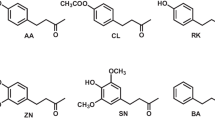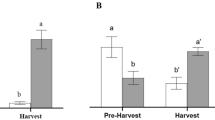Abstract
Queensland fruit fly, Bactrocera tryoni (Q-fly), is a major pest of horticultural crops in eastern Australia. Lures that attract male Q-fly are important for detection of incursions and outbreaks, monitoring of populations, and control by mass trapping and male annihilation. Cuelure, an analog of naturally occurring raspberry ketone, is the standard Q-fly lure, but it has limited efficacy compared with lures that are available for some other fruit flies such as methyl eugenol for B. dorsalis. Melolure is a more recently developed raspberry ketone analog that has shown better attraction than cuelure in some field studies but not in others. A novel fluorinated analog of raspberry ketone, raspberry ketone trifluoroacetate (RKTA), has been developed as a potential improvement on cuelure and melolure. RKTA placed on laboratory cages containing 2-week-old Q-flies elicited strong behavioral responses from males. Quantification of Q-fly responses in these cages, using digital images to estimate numbers of flies aggregated near different lures, showed RKTA attracted and arrested significantly more flies than did cuelure or melolure. RKTA shows good potential as a new lure for improved surveillance and control of Q-fly.


Similar content being viewed by others
References
Abràmoff MD, Magalhães PJ, Ram SJ (2004) Image processing with image. J Biophotonics Int 11:36–42
Alexander BH, Beroza M, Oda TA, Steiner LF, Miyashita DH, Mitchell WC (1962) The development of male melon fly attractants. J Agr Food Chem 10:270–276
Barthel WF, Green N, Keiser I, Steiner LF (1957) Anisylacetone, synthetic attractant for male melon fly. Science 126:654
Bauer L, Birch AJ, Ryan AJ (1955) Studies in relation to biosynthesis. VI. Rheosmin. Aust J Chem 8:534–538
Beroza M, Alexander BH, Steiner LF, Mitchell WC, Miyashita DH (1960) New synthetic lures for the male melon fly. Science 131:1044–1045
Casaña-Giner V, Oliver JE, Jang E, Carvalho L (2003a) Syntheses and behavioral evaluations of fluorinated and silylated analogs of raspberry ketone as attractants for the melon fly, Bactrocera cucurbitae (Coquillett). J Entomol Sci 38:111–119
Casaña-Giner V, Oliver JE, Jang EB, Carvalho L, Khrimian A, Demilo AB, Mcquate GT (2003b) Raspberry ketone formate as an attractant for the melon fly (Diptera: Tephritidae). J Entomol Sci 38:120–126
Chiang MY, Kao CH, Huang YB, Cheng EY, Lee MC (2007) Studies on small model area-wide control of the oriental fruit fly for wax apple in Taiwan. J Taiwan Agric Res 56:153–164
Christenson LD, Foote RH (1960) Biology of fruit flies. Annu Rev Entomol 5:171–192
Clarke AR, Powell LS, Weldon CW, Taylor PW (2011) The ecology of Bactrocera tryoni (Diptera: Tephritidae): what do we know to assist pest management? Ann Appl Biol 158:26–54
Dominiak BC, Daniels D (2012) Review of the past and present distribution of Mediterranean fruit fly (Ceratitis capitata Weidemann) and Queensland fruit fly (Bactrocera tryoni Froggatt) in Australia. Aust J Entomol 51:104–115
Dominiak BC, Kerruish B, Barchia I, Pradhan U, Gilchrist AS, Nicol HI (2011) The influence of mixtures of parapheromone lures on trapping of fruit fly in New South Wales, Australia. Plant Prot Q 26:136–140
Dominiak BC, Campbell AJ, Jang EB, Ramsey A, Fanson BG (2015) Field evaluation of melolure, a formate analogue of cuelure, and reassessment of fruit fly species trapped in Sydney, New South Wales, Australia. J Econ Entomol 108:1176–1181
Drew RAI (1989) The tropical fruit flies (Diptera: Tephritidae: Dacinae) of the Australasian and Oceanian regions. Mem Queensl Mus 26:1–521
Jang EB, Casana-Giner V, Oliver JE (2007) Field captures of wild melon fly (Diptera: Tephritidae) with an improved male attractant, raspberry ketone formate. J Econ Entomol 100:1124–1128
Jang EB, McQuate GT, McInnis DO, Harris EJ, Vargas RI, Bautista RC, Mau RF (2008) Targeted trapping, bait spray, sanitation, sterile-male and parasitoid releases in an areawide integrated melon fly (Diptera: Tephritidae) control program in Hawaii. Am Entomol 54:234–245
Jessup AJ, Dominiak B, Woods B, Lima CPFD, Tomkins A, Smallridge CJ (2007) Area-wide management of fruit flies in Australia. In: Vreysen MJB, Robinson AS, Hendrichs J (eds) Area-wide control of insect pests: from research to field implementation. Springer, Dordrecht, pp 685–697
Lloyd AC, Hamacek EL, Kopittke RA, Wyatt PM, Neale CJ, Eelkema M, Gu H (2010) Area-wide management of fruit flies (Diptera: Tephritidae) in the Central Burnett district of Queensland, Australia. Crop Prot 29:462–469
Manoukis NC, Jang EB (2013) The diurnal rhythmicity of Bactrocera cucurbitae (Diptera:Tephritidae) Attraction to cuelure: insights from an interruptable lure and computer vision. Ann Entomol Soc Am 106:136–142
Mau RFL, Jang EB, Vargas RI (2007) The Hawaii area-wide fruit fly pest management programme: influence of partnerships and a good education programme. In: Vreysen MJB, Robinson AS, Hendrichs J (eds) Area-wide control of insect pests: from research to field implementation. Springer, Dordrecht, pp 671–684
McPhail M (1939) Protein lures for fruit flies. J Econ Entomol 32:758–761
Metcalf RL (1990) Chemical ecology of Dacinae fruit flies (Diptera: Tephritidae). Ann Entomol Soc Am 83:1017–1030
Metcalf RL, Metcalf ER (1992) Fruit flies of the family tephritidae. In: Metcalf RL, Metcalf ER (eds) Plant kairomones in insect ecology and control. Chapman Hall, New York, pp 109–152
Metcalf RL, Mitchell WC, Metcalf ER (1983) Olfactory receptors in the melon fly Dacus cucurbitae and the oriental fruit fly Dacus dorsalis. Proc Natl Acad Sci U S A 80:3143–3147
Metcalf RL, Metcalf ER, Mitchell WC (1986) Benzyl acetate as attractants for male oriental fruit fly, Dacus dorsalis, and the male melon fly, Dacus cucurbitae. Proc Natl Acad Sci U S A 83:1549–1553
Neises B, Steglich W (1978) Simple method for the esterification of carboxylic acids. Angew Chem Int Edit 17:522–524
Oliver J (2007) Summary of national fruit fly-related activities released. Department of Agriculture, Fisheries and Forestry
Orankanok W, Chinvinijkul S, Thanaphum S, Sitilob P, Enkerlin WR (2007) Area-wide integrated control of oriental fruit fly Bactrocera dorsalis and guava fruit fly Bactrocera correcta in Thailand. In: Vreysen MJB, Robinson AS, Hendrichs J (eds) Area-wide control of insect pests: from research to field implementation. Springer, Dordrecht, pp 517–526
Osborne R, Meats A, Frommer M, Sved JA, Drew RAI, Robson MK (1997) Australian distribution of 17 species of fruit flies (Diptera:Tephritidae) caught in cue lure in February 1994. Ann Appl Biol 36:45–50
Rameash K, Thomas J, Chellapan M, Mathew MP (2009) Studies on dispensers of melolure in the attraction of melon fly, Bactrocera cucurbitae. Indian J Plant Prot 37:55–58
Royer JE (2015) Responses of fruit flies (Tephritidae: Dacinae) to novel male attractants in north Queensland, Australia, and improved lures for some pest species. Austral Entomol 54:411–426
Shelly T, Renshaw J, Dunivin R, Morris T, Giles T, Andress E, Diaz A, War M, Nishimoto J, Kurashima R (2013) Release-recapture of Bactrocera fruit flies (Diptera: Tephritidae): comparing the efficacy of liquid and solid formulations of male lures in Florida, California and Hawaii. Fla Entomol 96:305–317
Tan K, Nishida R, Jang E, Shelly T (2014) Pheromones, male lures, and trapping of Tephritid fruit flies. In: Shelly T, Epsky N, Jang EB, Reyes-Flores J, Vargas R (eds) Trapping and the detection, control, and regulation of Tephritid fruit flies. Springer, Netherlands, pp 15–74
van Rossum G (1995) Python tutorial. Technical report CSR9526. Centrum voor Wiskunde en Informatica (CWI), Amsterdam
Vargas RI, Mau RFL, Jang EB, Faust RM, Wong L (2008) The Hawaii fruit fly areawide pest management programme. In: Koul O, Cuperus G, Elliott N (eds) Areawide pest management: Theory and implementation. www.cabi.org, E-book, pp 300–325
Vargas RI, Piñero JC, Jang EB, Mau RFL, Stark JD, Gomez L, Stoltman L, Mafra-Neto A (2010a) Response of melon fly (Diptera: Tephritidae) to weathered SPLAT-spinosad-cue-lure. J Econ Entomol 103:1594–1602
Vargas RI, Piñero JC, Mau RFL, Jang EB, Klungness LM, Mcinnis DO, Harris EB, Mcquate GT, Bautista RC, Wong L (2010b) Area-wide suppression of the mediterranean fruit fly, Ceratitis capitata and the Oriental fruit fly, Bactrocera dorsalis (Diptera:Tephritidae) in Kamuela Hawaii. J Insect Sci 135:1–17
Wuts PGM, Greene TW (2006) Greene’s protective groups in organic synthesis, 4th edn. Wiley, Hoboken
Yonow T, Sutherst RW (1998) The geographical distribution of the Queensland fruit fly, Bactrocera (Dacus) tryoni, in relation to climate. Aust J Agric Res 49:935–953
Acknowledgments
The authors thank Andrew Jessup, Lori Carvalho, Janice Nagata, Anca Chirvasuta, Erika Babikow, and Ian Koons for assistance with bioassays and chemical synthesis. This project was funded by Horticulture Innovation Australia Limited using the Summerfruit, Citrus, Vegetables, and Rubus levy and funds from the Australian Government.
Author information
Authors and Affiliations
Corresponding author
Electronic Supplementary Material
Below is the link to the electronic supplementary material.
Figure S1
Lure response bioassay at New South Wales Department of Primary Industries, Central Coast Primary Industries Centre, Ourimbah. (a) Experimental setup showing fly cage, filter papers with lure compounds (indicated by arrows), and image capture equipment. (b) Close-up showing cameras (indicated by arrows). (DOCX 1.33 mb)
Rights and permissions
About this article
Cite this article
Siderhurst, M.S., Park, S.J., Buller, C.N. et al. Raspberry Ketone Trifluoroacetate, a New Attractant for the Queensland Fruit Fly, Bactrocera Tryoni (Froggatt). J Chem Ecol 42, 156–162 (2016). https://doi.org/10.1007/s10886-016-0673-3
Received:
Revised:
Accepted:
Published:
Issue Date:
DOI: https://doi.org/10.1007/s10886-016-0673-3




